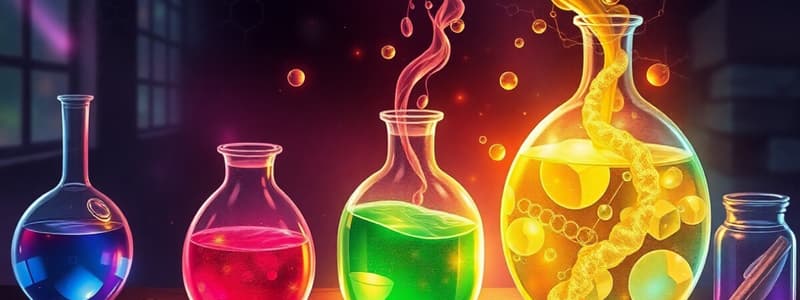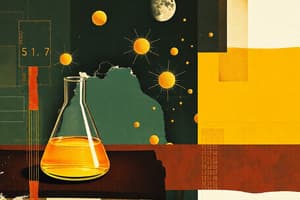Podcast
Questions and Answers
What is the pH level range for acids?
What is the pH level range for acids?
- 0-4
- 5-9
- 1-6 (correct)
- 7-14
Which of the following colors indicates the presence of a strong acid in a universal indicator?
Which of the following colors indicates the presence of a strong acid in a universal indicator?
- Green
- Blue
- Red (correct)
- Yellow
Which of the following statements about bases is incorrect?
Which of the following statements about bases is incorrect?
- Bases taste bitter.
- Weak bases can appear blue in a universal indicator.
- Strong bases have a pH level of 8-14.
- Strong bases turn universal indicator red. (correct)
What color does a weak acid typically appear in a universal indicator?
What color does a weak acid typically appear in a universal indicator?
What is a characteristic taste of bases?
What is a characteristic taste of bases?
What products are formed when an acid reacts with a metal carbonate?
What products are formed when an acid reacts with a metal carbonate?
Which of the following represents a worded equation for a combustion reaction?
Which of the following represents a worded equation for a combustion reaction?
When magnesium reacts with hydrochloric acid, what type of reaction occurs?
When magnesium reacts with hydrochloric acid, what type of reaction occurs?
Which of the following is NOT a product of the reaction between an acid and a base?
Which of the following is NOT a product of the reaction between an acid and a base?
Identify the correct worded equation for the combination of a non-metal with oxygen.
Identify the correct worded equation for the combination of a non-metal with oxygen.
Which statement best describes the reaction of a metal with oxygen?
Which statement best describes the reaction of a metal with oxygen?
What is the general outcome of a neutralization reaction?
What is the general outcome of a neutralization reaction?
In the context of acid reactions, which product is always formed when an acid reacts with a metal?
In the context of acid reactions, which product is always formed when an acid reacts with a metal?
Flashcards
Endothermic Reaction
Endothermic Reaction
A chemical reaction that absorbs heat from the surroundings.
Exothermic Reaction
Exothermic Reaction
A chemical reaction that releases heat to the surroundings.
Acid
Acid
A substance that has a sour taste, low pH levels (1-6), and turns universal indicator colors like red or green/yellow (depending on strength).
Base
Base
Signup and view all the flashcards
pH Level
pH Level
Signup and view all the flashcards
Neutralization Reaction
Neutralization Reaction
Signup and view all the flashcards
Acid + Carbonate
Acid + Carbonate
Signup and view all the flashcards
Acid + Metal
Acid + Metal
Signup and view all the flashcards
Metal + Oxygen
Metal + Oxygen
Signup and view all the flashcards
Non-metal + Oxygen
Non-metal + Oxygen
Signup and view all the flashcards
Combustion
Combustion
Signup and view all the flashcards
Hydrocarbon
Hydrocarbon
Signup and view all the flashcards
Study Notes
Chemical Reactions Revision
-
Physical vs. Chemical Changes:
- Physical changes alter appearance but not the substance's makeup (e.g., melting ice, dissolving salt).
- Chemical changes create new substances (e.g., burning wood, reacting magnesium with acid).
-
Indicators of Chemical Change:
- Production of light
- Production of heat
- Production of sound
- Change in colour
- Production of an odour
- Formation of bubbles or gases
- Formation of a precipitate (solid particles)
-
Reactants and Products:
- Reactants are the starting substances in a chemical reaction.
- Products are the substances formed as a result of the reaction.
-
Bond Changes in Reactions:
- Chemical bonds between atoms are broken and reformed in different ways during reactions.
-
Endothermic vs. Exothermic Reactions:
- Endothermic: Reactions absorb heat from the surroundings (e.g., ice melting, photosynthesis, ice packs).
- Exothermic: Reactions release heat to the surroundings (e.g., adding magnesium to acid, heat packs).
-
Neutralization Reactions:
- Acid + base → salt + water
- Example: hydrochloric acid + sodium hydroxide → sodium chloride + water
-
Acid-Metal Carbonate Reactions:
- Acid + metal carbonate → salt + water + carbon dioxide
- Example: citric acid + sodium bicarbonate → salt + water + carbon dioxide
-
Acid-Metal Reactions:
- Acid + metal → salt + hydrogen
- Example: magnesium + hydrochloric acid → magnesium chloride + hydrogen
-
Metal-Oxygen Reactions:
- Metal + oxygen → metal oxide
- Example: magnesium + oxygen → magnesium oxide
-
Non-Metal-Oxygen Reactions:
- Non-metal + oxygen → non-metal oxide
- Example: carbon + oxygen → carbon dioxide
-
Combustion Reactions:
- Fuel + oxygen → carbon dioxide + water (or hydrocarbon + oxygen → carbon dioxide + water)
Studying That Suits You
Use AI to generate personalized quizzes and flashcards to suit your learning preferences.




